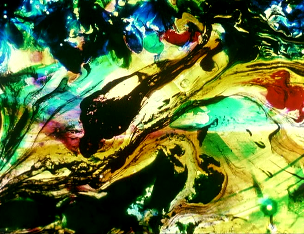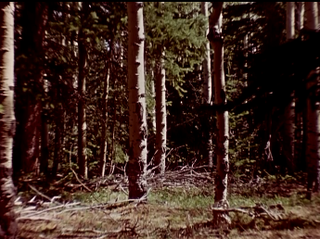
Hieronymus Bosch was a Dutch painter from Brabant. He is one of the most notable representatives of the Early Netherlandish painting school. His work, generally oil on oak wood, mainly contains fantastic illustrations of religious concepts and narratives. Within his lifetime, his work was collected in the Netherlands, Austria, and Spain, and widely copied, especially his macabre and nightmarish depictions of hell.

James Stanley Brakhage was an American experimental filmmaker. He is considered to be one of the most important figures in 20th-century experimental film.

The Garden of Earthly Delights is the modern title given to a triptych oil painting on oak panel painted by the Early Netherlandish master Hieronymus Bosch, between 1490 and 1510, when Bosch was between 40 and 60 years old. Bosch's religious beliefs are unknown, but interpretations of the work typically assume it is a warning against the perils of temptation. The outer panels place the work on the Third Day of Creation. The intricacy of its symbolism, particularly that of the central panel, has led to a wide range of scholarly interpretations over the centuries.

The Haywain Triptych is a panel painting by the Early Netherlandish painter Hieronymus Bosch, now in the Museo del Prado, Madrid, Spain. A date of around 1516 has been established by means of dendrochronological research. The central panel, signed "Jheronimus Bosch", measures 135 cm × 200 cm and the wings measure 147 cm × 66 cm. The outside shutters feature a version of Bosch's The Wayfarer.

Marie Menken was an American experimental filmmaker, painter, and socialite. She was noted for her unique filming style that incorporated collage. She was one of the first New York filmmakers to use a hand-held camera and trained Andy Warhol on its use. Her film Glimpse of the Garden was selected for preservation in the National Film Registry by the Library of Congress.

Mothlight is an experimental short film by Stan Brakhage, released in 1963. The film was created without the use of a camera.
The Garden of Earthly Delights is a painting by Hieronymus Bosch.
Eye Myth is an experimental short film by Stan Brakhage, produced in 1967. The film has a running time of only nine seconds, but took about a year to produce.
Cat's Cradle is an experimental short film by Stan Brakhage, produced in 1959. The film was described by Brakhage as "sexual witchcraft involving two couples and a 'medium' cat."

The Dante Quartet is an experimental short film by Stan Brakhage, completed in 1987. The film was inspired by Dante's Divine Comedy, and took six years to produce.
Fire of Waters is an experimental short film by Stan Brakhage, produced in 1965.

Commingled Containers is an experimental short film by Stan Brakhage, produced in 1997.

The Wold Shadow is an experimental short film by Stan Brakhage, produced in 1972.
Collage film is a style of film created by juxtaposing found footage from disparate sources. The term has also been applied to the physical collaging of materials onto film stock.

The Last Judgment is a triptych of disputed authorship, either by the Early Netherlandish master Hieronymus Bosch, his workshop, or a collaboration between artist and workshop. It was created after 1486. It is one of eight surviving triptychs by Bosch.
Jennifer Todd Reeves is a New York–based independent filmmaker. She has also taught as a part time professor of film at Bard College, The Cooper Union, Millennium Film Workshop and the School of Visual Arts.
Unglassed Windows Cast a Terrible Reflection is a 1953 American short film directed by Stan Brakhage. Shot while in Brakhage's native Denver, the film stars Larry Jordan who later went on to become a film director. Filming was done in Nevadaville, Colorado. Like his other films at the time, it was shot on 16mm film, is black and white and features no dialogue.
Anticipation of the Night is a 1958 American avant-garde film directed by Stan Brakhage. It was a breakthrough in the development of the lyrical style Brakhage used in his later films.
The Way to Shadow Garden is a 1955 American experimental film directed by Stan Brakhage.
Sirius Remembered is a 1959 American experimental short film directed by Stan Brakhage. It captures the gradual decomposition of the corpse of Sirius, the Brakhage family's dog, over the course of several months.










